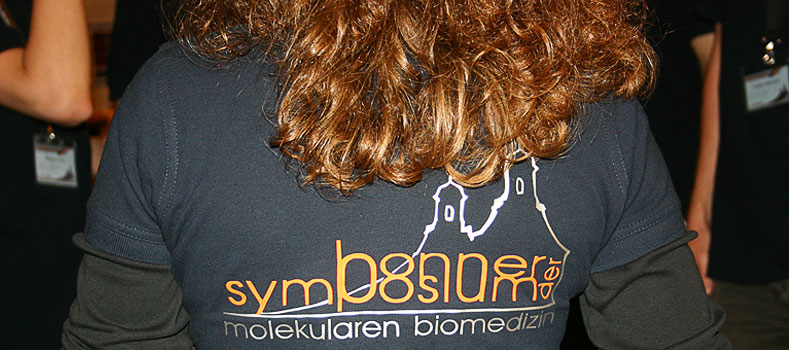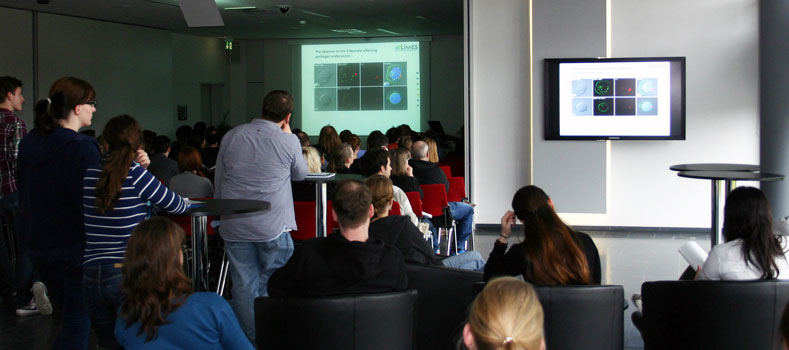Combining artificially created building blocks with natural ones - that is the goal of two new assistant professors at the University of Bonn. Biophysicist Dr. Alena Khmelinskaia and biophysical chemist Dr. Patrycja Kielb work at the interfaces of different disciplines and hold so-called Argelander professorships, two new posts created at the university with funds from the Excellence program. Such junior professorships are cornerstones within the concept of the six Transdisciplinary Research Areas (TRAs), in which researchers work jointly on future-relevant issues across the boundaries of disciplines and faculties. Alena Khmelinskaia and Patrycja Kielb are now building a bridge between chemistry, physics, and life sciences in the TRA "Building Blocks of Matter and Fundamental Interactions". Their work is relevant for the development of sustainable technologies in modern societies, for example, in medicine or energy research.
Biohybrids are structures that are partly biological and partly man-made. "This is a promising new field of research representing an area of chemistry with enormous potential, which we wish to unleash within the TRA 'Matter' in the years to come," explains Prof. Dr. Peter Vöhringer, spokesperson of the Transdisciplinary Research Area "Building Blocks of Matter and Fundamental Interactions" (TRA 'Matter') at the University of Bonn. The aim is to create hybrid systems in which a synthetic building block tailored for a specific function is linked to a natural biological component. These can be proteins, nucleic acids, or biomembranes, for example. "We expect such hybrid structures to provide improved functionality in numerous key technologies, such as chemical catalysis, energy conversion, or molecular sensing," emphasizes Peter Vöhringer.
Young researchers strengthen interdisciplinary research
"Alena Khmelinskaia and Patrycja Kielb are two outstanding scientists who pioneer creative new research approaches at the intersection of different disciplines. That's why we are delighted to have successfully recruited them as Argelander Professors," says Prof. Dr. Andreas Zimmer, Vice Rector for Research and Early-Career Researchers at the University of Bonn. "The professorships are a very important part of our university's transdisciplinary approach."
The objective of the Argelander Professorships (named after Bonn’s astronomer Friedrich Wilhelm August Argelander, †1875) is to systematically expand the research profile of the Transdisciplinary Research Areas established at the interfaces between the classical disciplines with funding from the Excellence strategy. This gives young researchers the opportunity to build their independent academic careers.
"For me, the appointments mark the beginning of a new development in the Chemistry Department of the Faculty of Mathematics and Natural Sciences," says Peter Vöhringer. "Together with a number of visionary minds in our department and our Transdisciplinary Research Area, we are working to open up new fields of research and launch innovative projects."
Design and self-assembly of proteins
At the LIMES Institute at the University of Bonn, biophysicist Alena Khmelinskaia is studying how proteins organize themselves - a ubiquitous phenomenon in all areas of life, including viruses. Protein building blocks are programmed to connect with each other through numerous molecular interactions and to adopt many different architectures, ranging from a myriad of crystals, filaments, and other three-dimensional assemblies. Alena Khmelinskaia and her research group want to decipher the physical interactions behind the self-assembly of proteins. She does this by combining modern theoretical computational methods, experiments in the test tube, and biophysical methods. Novel protein nanoparticles are created that do not yet exist in nature. "These proteins are very stable and resistant to structural changes compared to their natural counterparts," says Alena Khmelinskaia. "This makes them attractive tools to study the interplay of interactions in the construction of protein-based materials." The 30-year-old received her doctorate from the Ludwig Maximilian University for her work at the Max Planck Institute of Biochemistry in 2018 and was most recently a postdoctoral researcher at the Institute for Protein Design, University of Washington.
"The design of novel protein complexes is a highly exciting field of research, with multiple applications at the interfaces between biochemistry, biomedicine, biophysics, and theoretical (bio)chemistry," says Prof. Dr. Günter Mayer, member of the TRAs ‘Matter’ and ‘Life and Health’ and research group leader at the LIMES Institute. "Dr. Khmelinskaia's work offers excellent opportunities to establish new collaborations with colleagues within TRAs ‘Matter’ and ‘Life and Health’ and to establish new innovative research directions in the field of biohybrids at the university."
Interplay of physics and biochemistry
Biophysicist Patrycja Kielb, whose professorship is located at the Institute for Physical and Theoretical Chemistry of the Chemistry Department, is interested in how nature carries out complicated redox processes. These are chemical reactions, in which electrons are transferred from one reactant to another. Such transformations are necessary for key processes in environment and life, for instance biomass decomposition or cellular respiration, and they can be used to provide environmentally-friendly solutions in energy conversion technologies. At the heart of these processes in nature are so-called metalloenzymes, harboring natural redox building blocks like metal ions and redox amino acids which are capable of executing biochemical reactions in a highly optimal manner. With my research group, I would like to explore how we can harness and further engineer the unrivalled efficiency of such natural biological systems towards the development of artificial biohybrid systems applicable in, for instance, bioelectronic devices," says Patrycja Kielb. Such devices, interfacing electrodes and biological components, can provide new solutions in medical, nano- and energy technologies.
"The University of Bonn is a perfect place for me to build a multidisciplinary lab, and I look forward to many exciting collaborations," emphasizes Patrycja Kielb. Her experimental approach combines protein engineering and biochemistry, biophysics, and bioinorganic and physical chemistry. The 33-year-old received her doctorate from the Technical University of Berlin in 2017 and was most recently a postdoctoral researcher at the California Institute of Technology (Caltech) and the University of Potsdam.
Financing via WISNA
The two newly filled professorships are financed through the Federal and States Program for the Promotion of Young Scientists (so-called WISNA program). The initial appointment is for a total duration of six years at the W1 professorial level and includes an interim and a final evaluation of the researcher’s academic activities. A successful tenure-track phase serves as the stepping stone toward a permanent W2-professorship.
Transdisciplinary research at the University of Bonn
In the Transdisciplinary Research Area "Building Blocks of Matter and Fundamental Interactions", researchers want to study nature at different length scales in order to understand how the building blocks of matter interact with each other and how complex structures emerge. The two new Argelander professorships of TRA “Matter” also build thematic bridges to other Transdisciplinary Research Areas at the university: the Transdisciplinary Research Area "Life and Health" and, in part, the Transdisciplinary Research Area "Innovation and Technology for a Sustainable Future".
Contact:
Jun.-Prof. Dr. Alena Khmelinskaia
Life & Medical Sciences Institute (LIMES)
Universität Bonn
E-Mail: akhmelin@uni-bonn.de














![[Translate to englisch:] [Translate to englisch:]](/fileadmin/_processed_/8/7/csm_Khmelinskaia-pr-800x450_75d6cd70a9.jpg)